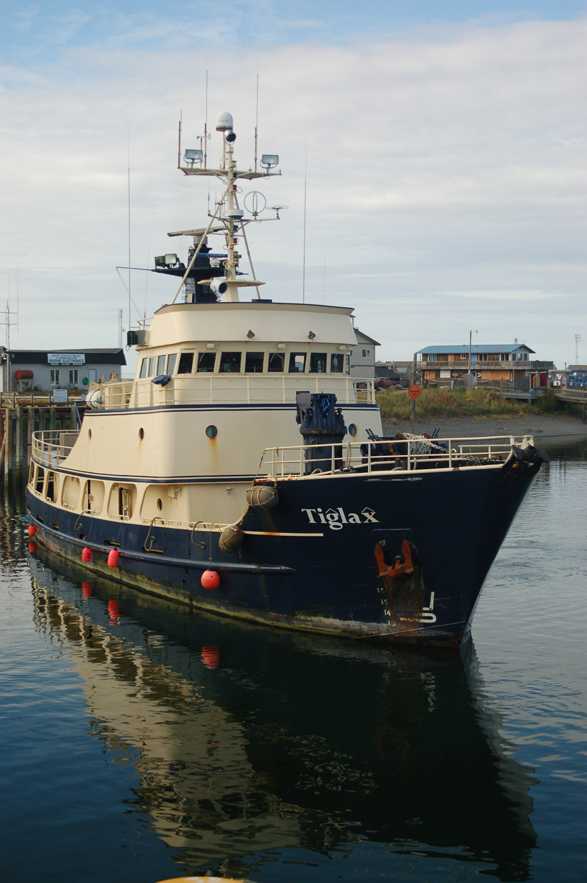Some mariners might think they’ve put a few miles on their engines this summer, but bragging rights in the harbor go to the workhorse of the U.S. Fish and Wildlife Service, the R/V Tiˆglaˆx. Just back last Friday from her five-month season, the research and transport ship that patrols the Alaska Maritime National Wildlife Refuge pegged 16,425 miles on her odometer.
That’s four times across the contiguous United States from Boston to Los Angeles “with a lot of speed bumps,” said Capt. Billy Pepper, all at an average of 10 knots. To give an idea of how slow that is, Pepper walked at a good clip across the bridge. Double that and you could keep up with the Tiˆglaˆx.
Assuming the U.S. Senate and the House of Representatives can agree on a continuing resolution to fund the federal government by Thursday, the Tiˆglaˆx — pronounced TEKH-lah, Unangan or Aleut for eagle — holds an open house, “Sailing Away to the Aleutians,” from 1 to 4 p.m. Saturday at the large vessel dock in the Homer Harbor — the dock accessible from Freight Dock Road. If the shutdown continues, the open house will be canceled.
Saturday’s open house also celebrates another milestone: the 100th anniversary of the creation of the Aleutian Islands Reserve, established in 1913 by President William Howard Taft. In 1909, President Theodore Roosevelt had created the first wildlife refuges in Alaska. In 1980 Alaska’s offshore islands were merged into what’s now the Alaska Maritime National Wildlife Refuge.
“It’s wonderful and amazing history, and we really hope we have a chance to share that with the public this Saturday,” said Poppy Benson, public programs supervisor for the wildlife refuge.
On Monday, Pepper, 56, and his crew of five worked to make the Tiˆglaˆx ship shape in advance of an anticipated shut down. Tuesday morning, Pepper gave his crew and himself a welcome home gift from Uncle Sam — a pink slip laying them off.
This is Pepper’s 19th season on the Tiˆglaˆx. He served as chief mate before succeeding the late Kevin Bell, who left the ship after becoming ill from cancer. Before working on the Tiˆglaˆx, Pepper was a commercial fisherman and a mariner with Neal & Company on the M/V Glacier.
A glance at the 2013 Tiˆglaˆx schedule shows how varied its work can be. Have a scientific research project in the Gulf of Alaska or Bering Sea you’d like to do? At $9,425 a day, government agencies, universities and other research groups can charter the Tiˆglaˆx. Reality shows need not apply, Pepper said.
“This is a reality show,” he said, joking. “Survivor Aleutians.”
The University of Alaska Fairbanks did a big project this summer, with 35 days total doing surveys of the Gulf of Alaska for the Global Ocean Ecosystem Dynamics study. Researchers have been doing things like collecting plankton to see the relationship between climate change and marine ecosystems — counting copepods, the tiny marine life at the bottom of the food chain for most fish.
Other projects included coastline surveys by the U.S. Fish and Wildlife Service and sea lion population surveys by the National Marine Fisheries Service. Since the 2008 eruption of Kasatochi Volcano near Adak, scientists also have been monitoring the return of plants and wildlife. More than 30 feet of ash covered the island.
“It’s completely a moonscape still,” Pepper said.
Birds, insects and some plants have begun to return, though.
The Tiˆglaˆx also has been stopping by Hawadax Island, formerly known as Rat Island, to check on a 2008 rat eradication program. Much of the ship’s work involves dropping off scientists and field camps, installing interpretive markers and FUDS work — formerly used defense sites, a reminder that Kiska and Attu once were battle zones 70 years ago when the U.S. military retook the islands occupied by Japan during World War II.
That mix of scientists leads to some interesting meal time discussions, Pepper said.
“You meet a lot of people who are dedicated and want to do good,” he said. “You hope you get an awareness out there that what we’re doing is affecting the planet.”
Unusual wildlife sightings this summer included a Baird’s beaked whale, Buller’s shearwaters and a leatherback turtle. That sighting was only the 19th in the Gulf of Alaska since 1966, Pepper said.
“It’s beautiful in the summer — once the fog lifts. You’ve got to like gray,” Pepper said of the Aleutians. “It sure as hell is an adventure. And it’s a hell of a sea boat.”
U.S. Fish and Wildlife Service R/V Tiˆglaˆx (TEKH-lah: Unangan or Aleut for eagle)
Open House:
Sail Away to the Aleutians
1-4 p.m. Saturday
Large vessel dock off of Freight Dock Road
(May be canceled due to U.S. Government shutdown)
Built: 1987
Home Port: Homer
Captain: Billy Pepper
Length: 120 feet
Weight: 415 tons (unladen)
Crew: 6
Passengers: 14
Facilities: fully-equipped galley; lounge/mess for up to 20 people; 4,800-cubic-feet of cargo space; fore and aft crane for loading
Skiffs: Four 17-foot outboard-powered inflatable boats to transport gear or workers
Fuel Capacity: 37,000 gallons
Range: 10,000 miles without refueling
2013 mileage: 16,425 miles, or four times across the United States from Boston to Los Angeles
Speed: cruises at 10 knots
Navigation Equipment: X and S-band radar, sonar, GPS, depth sounders
Communications: satellite phone, HF sideband, marine VHF, WxFax
Charter price (scientific trips only): $9,525 a day


